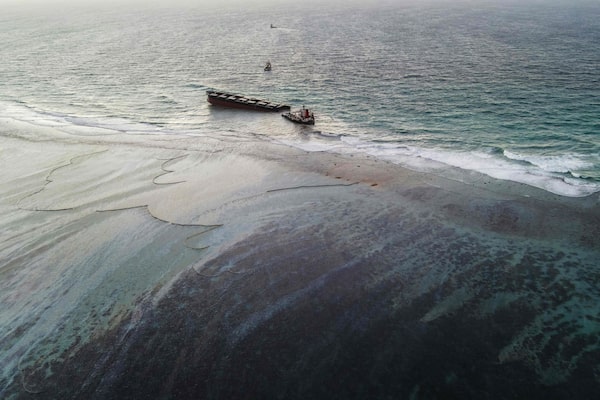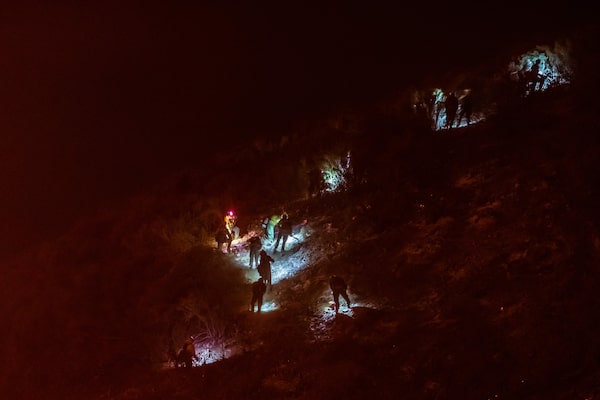Good afternoon, and welcome to Globe Climate, a newsletter about climate change, environment and resources in Canada.
By now, we’ve heard a lot about the oil spill that happened in Mauritius.
The country is seeking compensation from the owners of the ship that spilled 1,000 tons of its cargo of 4,000 tons of oil into the sea. Most recently, following a government request for assistance, India dispatched over 30 tonnes of technical equipment and material by aircraft to supplement the country’s salvage operations.
But how are researchers preparing for Canada’s next major oil spill? Check out our archives for this piece on “Slick Science” and how controlled leaks of Alberta bitumen in the Ontario wilderness are teaching scientists about the behaviour of big petrochemical disasters and how to clean up after them – insights that are needed now more than ever.
Now, let’s catch you up on other news.

This aerial picture taken on August 16, 2020, shows the MV Wakashio bulk carrier that had run aground and broke into two parts near Blue Bay Marine Park, Mauritius.STRINGER/AFP/Getty Images
Noteworthy reporting this week:
- For decades cities have favoured cement over greenery, largely because it’s cheap and requires little maintenance. But now, some city dwellers are desperate to return to their grassroots. Read about those who are choosing to depave their properties - revealing the natural earth beneath.
- Joe Biden and Kamala Harris teamed up last week to take a shot at the American presidency. Globe Columnist John Ibbitson says we should welcome Biden and Harris, as Canada can’t take four more years of Trump: “Though Mr. Biden’s vow to kill the Keystone XL pipeline would be bad news for the oil sector, Canada would welcome a renewed American commitment to combat climate change,” he writes.
Janet Joy Wilson poses for a photo in her driveway, which she is gradually depaving and converting into a garden, in Toronto, Saturday, July 18, 2020.Galit Rodan/The Globe and Mail
A deeper dive
Big oil patch names join legal battle
Ryan MacDonald is a senior editor at The Globe heading the climate, environment and resources team. For this week’s deeper dive, he looks at some of our recent Arctic reporting.
A trio of oil companies joining a bankruptcy battle may seem mundane, but the longer-term implications make it worth watching.
As Jeffrey Jones reports, these companies - Canadian Natural Resources Ltd., Cenovus Energy Inc. and Torxen Energy Ltd. – hold nearly a third of the well licences in Alberta. The companies are intervening in support of the trustee for insolvent Sequoia Resources Corp.
The trustee sued Perpetual Energy Corp., which in 2016 sold Sequoia natural gas wells that carried an estimated $134-million of cleanup liabilities. Sequoia went into receivership in 2018, when it was no longer able to pay its bills, leaving an estimated $225-million in abandonment and reclamation costs. Perpetual says the case is without merit and is seeking to have it tossed out.
Why is this important?
The trio adds heft to a case connected to the problems of underfunded environmental liabilities and orphan wells in the oil patch. The industry’s cleanup bill is now in the tens of billions of dollars, and has been complicated by large, players selling off aging assets with high future abandonment and reclamation costs to small producers with limited financial means.
The Globe and Mail has covered these issues at length, beginning with its award-winning investigation, Hustle in the oil patch. To understand the complexities of what’s happening, what’s at stake and what the future holds it’s worth a re-read.
Interestingly, Alberta’s Orphan Well Association is also joining the bankruptcy fight. That development matters because these companies pay into the OWA, which cleans up abandoned wells, and don’t want to be on the hook for their share of the Sequoia liabilities should its wells be rendered orphans in the bankruptcy.
More importantly, this case matters because you, the taxpayer, now bear some of costs of these bankruptcies. While cleanup is supposed to be covered by industry, taxpayers now also bear the some of the costs, after the federal and Alberta governments earmarked hundreds of millions of dollars for decommissioning inactive wells.
So, while taxpayers did not create the problem, they now have a stake in the cleanup. Yes, governments argue it’s a way to create and maintain jobs during a global pandemic that has hit the energy industry hard, but it also runs counter to the polluter pay principle.
In one important case, we’ll see in October how it all plays out.
- Ryan
Dave Marks of the Alberta Orphan Well Association checks out an abandoned well site they will decommission near High River, Alberta, August 12, 2020.Todd Korol/The Globe and Mail
What else you missed
Trudeau, Morneau clash over green plans, soaring deficit: Morneau’s resistance to expensive environmental initiatives reflects his roots in Bay Street, and a view held among right-leaning Liberals that deficits are out of control.
Australian billionaire woos Canadians, hoping to build big coal mine in Rocky Mountains: Mining magnate Gina Rinehart’s Hancock Prospecting Pty wants to overcome opposition to the massive new coal mine. Public hearings are slated to begin in October for the Grassy Mountain, which requires federal and provincial approvals.
As Canada curbs methane emissions, new measurements show problem bigger than thought: Reported greenhouse gas emissions from Canada’s oil patch have more than doubled in the year’s first half as changes to how they are measured revealed a more extensive picture of environmental damage, previously unreported industry data show
Why investor interest in sustainable investments continues to rise: The COVID-19 crisis has also highlighted income and health inequalities that exist in many countries around the world.
Greenland ice has shrunk beyond return: Scientists studied data on 234 glaciers across the Arctic territory spanning 34 years through 2018 and found that annual snowfall was no longer enough to replenish glaciers of the snow and ice being lost to summertime melting.
Opinion and analysis
Lashing out at critics won’t revive Alberta’s oil sands. What’s needed is action
Editorial board: “Alberta and Canada need to show the world this country is serious about reducing oil sands emissions, if we want to keep selling bitumen. Show, don’t tell.”
Change to believe in: Democrats, the party of perpetual flux, prepare for the Biden banner
David Shribman: “... The pair calculated that this was the year to work for fundamental change: a broad centralized health-insurance scheme to cover all Americans, far-reaching environmental structures to fight global climate change, dramatic changes in the tax code to battle the wealth gap.”
Here’s what readers had to say
Last week a lots of readers discussed in the comments of another Data Dive with Nik Nanos story. Nanos looked into how the pandemic has changed our views on climate change:
- Year of the Mule: “You don’t have a healthy economy without a healthy environment. You might think you do but that’s just because accounting practices don’t consider external costs dumped on the environment that ‘nobody’ pays for.”
- 4793: “Why don’t the pollsters ever ask the same people who they think should pay for the green shift and how much more THEY would be willing to pay?”
- KellyStevenRoss: “I’m all in favour of protecting our environment and dealing with man made climate change. Almost everyone is. Interesting the Prairies are cited so often as not caring about climate change. The reason is it’s just another issue being dictated to us from the East.”
- To which Mark Shore replied: “Alberta and Saskatchewan have per capita greenhouse gas emissions that are more than 3x the Canadian average, and 6x the average of Ontario, Quebec and BC. Maybe that, coupled with the fact western politicians have long tried to obstruct any and all attempts to address this, even to the point of denying that climate change is a problem or even exists, has something to do with it.”
Making waves
Each week The Globe will profile a young person making a difference in Canada. This week we’re highlighting the work of Kyla Gilbert doing environment and wildlife focused art.
Kyle Gilbert's "Senescene has its purpose"Supplied
Hi, my name is Kyla Gilbert. I’m a 28 year-old visual artist with a background in environmental and wildlife technology and in performance. I’m based out of Vancouver, where I’m doing my grad studies at Emily Carr University of Art + Design.
My research revolves around the use of synthetics, and the commodification of living organisms, and environments.
A lot of environmental discourse places hope in technological salvation, removed from our reality and devoid of specific political implications. The world is in a continuous state of colonization, while we speak of a return to an idealized “nature”.
It's important to initiate change from where you're situated, to start from your own body, your own community, the things you can touch, and expand outwards. This is why I love sculpture. It allows an idea to be physicalized outside of its creator.
The environment is you, me and the lead that's in my water and the micro plastics that end up in my body. It's the hazardous waste that disproportionately affects Indigenous and Black communities. The environment is mountains, and factory farms, and open-pit mines.
My work is about trying to embody my lived reality, all the confusion and contradiction and contamination.
- Kyla
Do you know an engaged young person? Someone who represents the real engines pursuing change in the country? Email us at GlobeClimate@globeandmail.com to tell us about them.
Photo of the week

Firefighters work at night cutting trees and removing vegetation in order to make a firebreak as they battle the Lake Fire in the Angeles National Forest, by Lake Hughes, 60 miles north of Los Angeles, California on August 15, 2020. - The Lake fire already burned more han 17000 acres and it is 12% contained according to SoCal Air Operations.APU GOMES/AFP/Getty Images
Guides and Explainers
- We’ve rounded up our reporters’ content to help you learn about sustainable ways to live life at home, travel, invest, and generally to learn about our species at risk.
- If you like to read, here are books to help the environmentalist in you grow, as well as a downloadable e-book of Micro skills - Little Steps to Big Change.
Catch up on Globe Climate
- Collapse of Canadian ice shelf a sign of a tipping point in the Arctic
- Alberta is having a moment with Europe in addressing climate risks
- Without Alberta, Canada can’t hit its goal of net-zero emissions by 2050, Natural Resources Minster says
- Arctic scientists turn to local communities for support as pandemic sidelines research
We want to hear from you. Email us: GlobeClimate@globeandmail.com. Do you know someone who needs this newsletter? Send them to our Newsletters page.